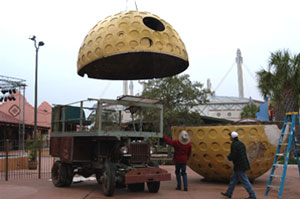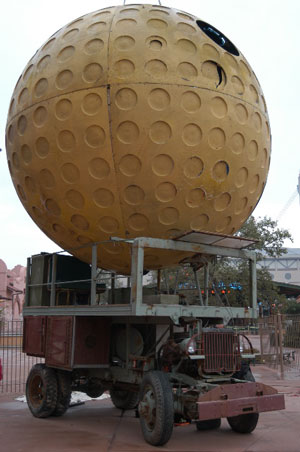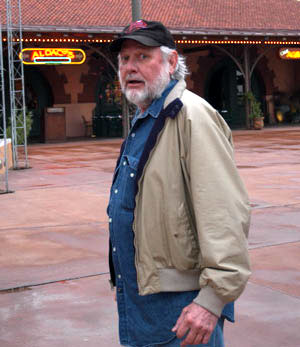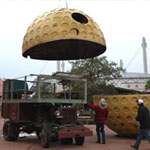During the 1980s Washington, DC enjoyed a vibrant art scene — a time when it was fun, inspiring and profitable to be an artist.
Prominently at the center of the scene was the WPA (Washington Project for the Arts), which produced exhibitions at its downtown location, threw great parties, and acted as a nexus for artists and collectors in the area. The WPA overspent during that boom, and when the bottom dropped out of the art market it almost disappeared altogether. Instead of growing, DC lost a generation of artists during the 1990s.
Artists from the city return to the same image time and again if probed about their memories of the 80s. The icon of those big times was a pair of gigantic cowboy boots produced as a site-specific project at the WPA. The boots, and artist Bob Wade’s stay, are a golden memory for many of those who were there. (The boots live on — currently visible from the Connally Loop in San Antonio, they make quite a statement at five stories tall.) To the DC area art community they weren’t an art object, though; they were a symbol of the fun of being an artist, as a maker, a celebrant — a hero.
Like that of DC, Austin’s art scene has taken its own wild ride. The heady days of the late 90s, when we thought Austin would soon have museum buildings by Richard Gluckman and Herzog & de Meuron, have given way to the Austin of 2004: a city with a busted economy and no glorious new building by a fancy architect. And unlike the artists in DC, we have no boots even to look back on as symbol of our glory days.
Life’s complexity always resists, and resists formidably, our simple visions for the future. That resistance engenders complacency, acceptance of the status quo, and attrition. But it can also yield the opportunity to probe experience and tweak our vision-production mechanism, in hopes of building ever more robust visions. As artists we can cull objects, concepts and metaphors that will inspire and remind us as we lean forward into the future we hope for. The microcosmic act of creating an individual work of art can provide a template for approaching the macro of creating our lives as individuals, families and whole communities.
Turns out that Bob “Daddy-O” Wade has created a new work that, for reasons all its own, is as electric as his DC boots. Driving the Ball Texas Style is Bob’s addition to the Texas Uprising sculpture show at Blue Star Contemporary Artspace in San Antonio. The show features indoor and outdoor work by 41 sculptors from Texas. It is the kind of survey show that inspires assessment of the regional scene from standpoints of age, materials, themes, influence, and future trends. As a uniquely sculpture-specific spectacle, it’s a chance sculptors love to meet up and celebrate the special brand of tenacity that sculpture making requires. Daddy-O’s piece steals the show.
Driving the Ball is the simple combination of a sixteen-foot fiberglass golf ball and a custom-made ranch hunting vehicle. The ball reaches 24 feet mounted atop the hunting rack, and is secured by two bright yellow ratchet straps. This “simple” combination delivers its punch and its philosophic depth in its dilapidated rendering. The ball is comprised of eight deca-spheres. It is scraped, battered and has holes in it — a big opening at the top was from the ball’s original life at a driving range — hit one in and get a free bucket of balls! It is as battered and cratered as the moon. The “swamp buggy” used to be a fire engine, and comes across as the prehistoric ancestor of the humvee. Both ball and “monster” embody their previous multiple lives. The buggy’s rack has been reinforced with 4×4 wood posts to ensure it doesn’t collapse under the ball. It has a sort of proud-but-battered geriatric swagger — “still standing, ain”t I?!”
The piece trumpets a uniquely Texas can-do. It both celebrates and subverts Texas braggadocio with its colossal ugliness and humor. It mocks the machismo of the “long drive” in golf and the “big kill” in hunting. It also subverts the macho sculptor stereotype, and the real sculpture prejudice against engineering and craft. Show participant Mac Whitney suggested that Bob’s engineering was unsafe, and Michelle O’Michael feared that the slap-dash appearance of the work would “spoil the whole show for everybody.”
It takes guts to tell a joke — the teller exposes himself or herself to the rejection of the audience. Driving the Ball risks the joke as concept, and also hints at the real risks taken in delivering this 3-D joke. Daddy-O flaunts his no-sculpture-studio status with a work whose very construction was a performance in risk and ingenuity.
The ball was purchased for less than $1000 in Waco and sat in a friend’s yard as plans were developed and fell through to take it to Manhattan and add a Statue of Liberty crown and face, and the swamp buggy was offered years ago as an Art Car parade possibility by a collector three hours south of San Antonio. Bob and his friend “Styles” drove the golf ball from Austin on the access road, constantly looking in the rear-view to make sure the deca-spheres were staying secure. It took four men and a crane three days of tweaking and re-tweaking and corrective propping and buttressing to get the assembly together at the site. The piece had no production budget and little market potential. When asked what the best hopes are for the March 14th de-installation deadline, Bob says, “Blue Star would be an option — paint it blue!”
Driving the Ball Texas Style does not appear to be the product of contemplative, funded, carefully crafted studio output. Bob got a call from Bill Fitzgibbons, director at Blue Star, requesting something big and wonderful for the show. With a month or so to the opening, Bob brought together elements physically from all over the region — bits and pieces of things that had been percolating and misfiring as other potential projects. He had a simple vision and not much of a game plan, but he had the courage and the caginess of a veteran. At how many points along the way could he have quit? How many unforeseen complexities arose that had to be resolved? When a quarter of the ball was in San Antonio, but the other six pieces stranded in Austin? When the two elements that he thought might work together finally got to the same place and didn’t quite fit? When it rained all through the installation? When the bolt holes of the ball started stripping out when the crane started letting it go? When the swamp buggy started listing overnight?
Texas Uprising presents many artfully realized works. Stepping off the shuttle during the drizzling rain at the opening in front of Driving the Ball Texas Style I saw something not of artifice — I saw something TRUE. It is funny, big, monstrous and pathetic. It is simple, yet it tells of its complex birth and past lives. It is an object that speaks plainly to the art world, and to the country club set, and to Bubba. Twenty-five years ago Bob made his DC boots, and they have had their impact on multiple generations of artists and admirers. Bob’s effort here is a “Texas Uprising,” and the art community around the state can learn from his wit, tenacity, courage and humor. Now we have a common image to associate with our cause — which is to thrive in a complex world.
Images courtesy the artist and Blue Star Art Space.
Randy Jewart is a sculptor and writer living in Austin.







1 comment
Being the first time I have seen this article, I hate to be mis-quoted. I was concerned about the structural safety as it was in a high pedestrian traffic area where children could climb on it. My concern resulted in the straps. It was a good show. Bob’s piece was fun.